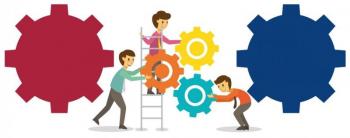

More cooperators than competitive
17/09/2020
Lefties are not very common and have always been a puzzle for researchers. In fact, they only represent approximately 10% of the population and throughout history they have been viewed with suspicion and have even been persecuted. This is why the word "sinister" derives from the term "left or left hand."
Two researchers from Northwest University, whose study has been published in the Journal of the Royal Society Interface, have concluded that a high degree of cooperation between the human species plays a key role in defining being left-handed. . Both experts have developed a mathematical model that reveals that the low percentage of people who use the left hand is the result of the imbalance between cooperation and competition in the evolution of the human being.
Professor Daniel M. Abrams and Mark J. Panaggio - both right-handed - are the first to use real-world data (drawn from a sample of elite athletes) to test and confirm the hypothesis that social behavior is related to level of use of the hands of the population.
More cooperators than competitive
"The more social the animal is - where cooperation is highly appreciated - the greater the population's tendency will be to one side," says Abrams, professor of science and mathematics at the McCormick School of Engineering and Applied Science. «The most important factor for an efficient society is a high degree of cooperation. In humans, this has occurred in a majority of right-handers, "he says.
In a fully cooperative society, the hypotheses suggest that everyone would have the same dominant hand. In this way, Abrams' analysis tries to confirm this speculation: the fact that there are 10% of left-handed people indicates that the human species is not fully cooperative.
"If societies were fully cooperative, everyone would use the same hand, says Abrams." Also, if competition were more important, one might expect the population to be right or left handed at a ratio of 50-50.
In a fight, a left-hander would have an advantage over a right-hander
On the one hand, cooperation would favor the use of the same hand - to be able to share the same tools - and on the other hand, physical competition would promote the use of the left. In a fight, a left-hander would have an advantage over a right-hander.
Abrams and Panaggio focused on data collected from a sample of elite athletes to support the theory of the necessary balance between cooperation and competition of the human species.
His model predicts that the number of successful left-handed athletes make up more than 50% for baseball, boxing, hockey and fencing and more than 10% for other sports such as table tennis. However, the number of successful left-handed golfers is very low, only 4%.
"The accuracy of our model's predictions when referring to a sample of athletes supports the idea that it can be extrapolated to the rest of society," says Abrams.
Manual laterality, the preference for using one hand over the other, is largely due to genetics and partly to the environment. Identical twins, who share exactly the same genes, don't always use the same hand.
Two researchers from Northwest University, whose study has been published in the Journal of the Royal Society Interface, have concluded that a high degree of cooperation between the human species plays a key role in defining being left-handed. . Both experts have developed a mathematical model that reveals that the low percentage of people who use the left hand is the result of the imbalance between cooperation and competition in the evolution of the human being.
Professor Daniel M. Abrams and Mark J. Panaggio - both right-handed - are the first to use real-world data (drawn from a sample of elite athletes) to test and confirm the hypothesis that social behavior is related to level of use of the hands of the population.
More cooperators than competitive
"The more social the animal is - where cooperation is highly appreciated - the greater the population's tendency will be to one side," says Abrams, professor of science and mathematics at the McCormick School of Engineering and Applied Science. «The most important factor for an efficient society is a high degree of cooperation. In humans, this has occurred in a majority of right-handers, "he says.
In a fully cooperative society, the hypotheses suggest that everyone would have the same dominant hand. In this way, Abrams' analysis tries to confirm this speculation: the fact that there are 10% of left-handed people indicates that the human species is not fully cooperative.
"If societies were fully cooperative, everyone would use the same hand, says Abrams." Also, if competition were more important, one might expect the population to be right or left handed at a ratio of 50-50.
In a fight, a left-hander would have an advantage over a right-hander
On the one hand, cooperation would favor the use of the same hand - to be able to share the same tools - and on the other hand, physical competition would promote the use of the left. In a fight, a left-hander would have an advantage over a right-hander.
Abrams and Panaggio focused on data collected from a sample of elite athletes to support the theory of the necessary balance between cooperation and competition of the human species.
His model predicts that the number of successful left-handed athletes make up more than 50% for baseball, boxing, hockey and fencing and more than 10% for other sports such as table tennis. However, the number of successful left-handed golfers is very low, only 4%.
"The accuracy of our model's predictions when referring to a sample of athletes supports the idea that it can be extrapolated to the rest of society," says Abrams.
Manual laterality, the preference for using one hand over the other, is largely due to genetics and partly to the environment. Identical twins, who share exactly the same genes, don't always use the same hand.















